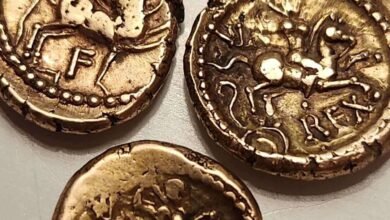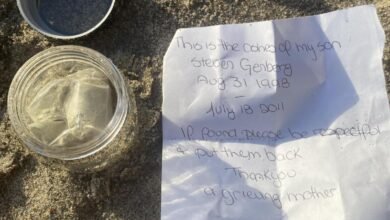This Spanish treasure comes partly from space

- An ancient Spanish treasure discovered 60 years ago yielded some surprising new results as tests showed pieces were made of meteorite iron.
- The treasure contains several gold items and has been dated to the Iberian Bronze Age.
- The 66-item find is known as the Treasure of Villena and is located in Spain.
There is controversy surrounding an ancient gold treasure discovered in 1963. But not because of disputes over who owns the 66-piece find, but over what exactly is in the mix. The crucial sticking point? An open bracelet or ring and a hollow hemisphere, two of the less glamorous pieces in the collection known as the “Treasure of Villena.”
It turns out that a meteorite could answer all the questions.
A new study published in Trabajos de PrehistoryThe aim is to quell controversy about the origin of the metals from which the two pieces in question are made. New data shows that “both pieces are composed of meteoritic iron, implying the possibility of placing their chronology at some point in the Late Bronze Age, before the start of terrestrial iron production.”
Originally discovered by Jose Maria Soler on December 1, 1963, the set consists of 66 metal pieces and includes bowls, bracelets, bottles and gold ornaments. Some pieces mix metals – there are three silver bottles, an iron bracelet, another iron piece with gold trim, and an amber and gold button. In total, according to the Jose Maria Soler Archaeological Museum, the collection includes almost 22 pounds of gold and is considered “the most important prehistoric treasure in Europe.”
Although iron is not as noticeable as gold, the origin of the iron in the collection puzzled experts. The dating of the gold found on the Iberian Peninsula gave a period between 1200 BC and 1200 BC. BC and possibly even 1500 BC. The Iron Age and terrestrial iron smelting did not take place on the peninsula until 850 BC at the earliest. took place. This means that the iron-like elements from the Villena treasure presented a dating problem.
Apparently that’s an equation a meteorite can solve. The current study analyzed the nickel content of the two pieces and showed that the high nickel content is consistent with iron coming from a meteor.
As part of the study, small samples of both items were taken for mass spectrometry measurements. The high corrosion rate will not provide a completely conclusive result, but still gives the authors enough confidence to claim that a meteorite was the source of the ferrous metal found in the treasure.
The find not only matches the age of the gold from the Villena hoard, but also means that this is the first known existence of meteoritic iron used in production on the Iberian Peninsula.
“Iron was just as valuable as gold or silver, and in this case [it was] used for ornamentation or decorative purposes,” said study co-author Ignacio Montero Ruiz, a researcher at the Spanish National Research Council’s Institute of History Smithsonian Magazine.
Montero Ruiz noted that the use of “unusual raw materials” shows that a highly skilled metalworker was developing new technologies. The fact that the pieces were included in the treasure mix – believed to have come from an entire community rather than an individual – showed their “enormous value”.
Tim Newcomb is a journalist based in the Pacific Northwest. He covers stadiums, sneakers, gear, infrastructure and more for a variety of publications, including Popular Mechanics. Some of his favorite interviews included meetings with Roger Federer in Switzerland, Kobe Bryant in Los Angeles and Tinker Hatfield in Portland.



